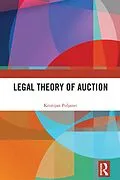The widespread understanding of auction structure considers auction as consisting of three contracts: contract between the seller and the auctioneer, contract between the auctioneer and the buyer and the sale contract between the seller and the buyer. The book challenges this concept, arguing that the traditional tripartite concept of auction is too narrow and does not correspond to the actual structure of auction relations.
Demonstrating that an auction structure consists of a plethora of legal relationships, including noncontractual relations, this book explores the legal concept of auction sale and the structure of accompanying relations. The book provides a historical overview of auctions and different auction models. Following a brief introduction to the economic theory, auction models are examined against the following legal criteria: price formation, publicity, parties' autonomy, legal form and applied technology to find a legal concept and nature of auction. The book explores the legal position of key auction figures and auction objects to identify the categories of legal relations that appear at auction. It explores the legal nature of the main contract, as well as the relations between the consignor and the auctioneer, the auctioneer and the bidders, the bidders themselves, the consignor and the bidders. The book covers relations arising from droit de suite, financial and bidding agreements to provide a comprehensive overview of lesserknown legal relations that commonly arise in auction practice.
Autorentext
Kristijan Poljanec is a Postdoctoral Researcher in Law at the University of Zagreb, Croatia.
Inhalt
PREFACE
LIST OF ACRONYMS
LIST OF ABBREVIATIONS
TABLE OF CASES
TABLE OF LEGISLATION
TABLE OF CONTENTS
INTRODUCTION
Price-determination methods
Brief note on the auction history
The rationale for this book
About comparative legal method adopted in this book
Lack of comparative researches
Local character of auction sales
Self-regulatory character of auction rules
Fragmentary character of auction law
The comparative method
The objectives of the comparison
Contents of this book and the problems covered
Defining the legal concept of auction
Defining the structure of auction relationships
Defining the legal concept of internet auction
Filling the gaps in the EU resale right regime
Defining the legal nature of auction guarantees and influence thereof on the position of the auctioneer
Finding a demarcation line between licit and illicit price-influencing tactics at auction
CHAPTER 1: LEGAL CONCEPT OF AUCTION
Introduction
Economic concept of auction
Models
One-sided and double-sided auctions
Private value and common value auctions
Open-bid auctions and sealed bid auctions
Revenue equivalence theorem
The theorem
The critics of the theorem
Legal concept of auction
Typical models
Ascending (English) auction
Features
Public and private auctions
Written and oral auctions
Absentee bids
Limited and unlimited absentee bids
Descending (Dutch) auction
Features
Subcategories
Is Dutch auction an auction at all?
Auction and auctionlike bidding mechanisms
Games of chance and auctions
'Controlled' uncertainty
No risk of losing the stake
Purpose
Competitive bidding
Public procurement and auction
Stock exchange and auction
Auction and the public promise of a reward
Interim conclusion
CHAPTER 2: AUCTION RELATIONSHIPS
Introduction
Auction participants
Seller
Auctioneer
The notion
Consigned and property auction
Bidders
Objects
Legal relationships at English auction
Consignment agreement
Continental law
Intermediation
Representation
Direct representation
Indirect representation
Auctioneers acting as sole contractor
Ambiguities concerning representation
Rights and duties of the auctioneer
Fiduciary duties of the auctioneer
Personal engagement in carrying out the mandate
Avoidance of conflict of interest
Adherence to the consignor's instructions
Receipt of the price
Rights
Brokerage fee
Damages
Advances
Anglo-American law
Agency
Rights and duties of the auctioneer
The authority of the auctioneer
Fiduciary duty
Personal engagement of the auctioneer
Receipt of the price
Rights
Brokerage fee
Indemnities
Relationship between the auctioneer and the bidders
Continental law
Anglo-American law
The relationships between the bidders
Contract of sale
Continental law
Theory of invitation
The existence of an offer
The effect of the last (in)valid bid for previous bids
Higher bid
Duration of a bid
Notification of the knock-down
Auction sale with a 'retention of higher offer' clause (in diem addictio)
Legal implications of the auction sale
Transfer of risks and conveyance of property
The reserve price
Anglo-American law
Sale with reserve
Conditional auction
Sale without reserve (absolute auction sale)
Sale without restrictions
Transfer of risks and property
Legal relationships (Dutch auction)
Interim conclusion
CHAPTER 3: INTERNET AUCTION
Introduction
The legal concept of internet auction
Internet auction and other distance sales
Auction models
English (ascending) and Dutch (descending) auction
Sealed bid auctions
Live auctions and combined Internet auctions
Business-to-consumer auction
Consumer-to-consumer auction
Business-to-business auction
Business-to-administration (business-to-government) auction
Government-to-consumer auction
Proprietary and intermediary auctions
User-to-consumer and auctioneer-to-consumer auctions
'Pay to sell' and 'pay to buy' auctions
Differences between internet and physical auction
Auction platform as a neutral intermediary
Auction platform as an auctioneer
The agency character of an auction platform
Virtual knock-down: functional equivalent to the traditional fall of the hammer
Closing remarks
Disadvantages of internet auctioneering
Anonymity
Risks of mistakes
Security risks
Delocalization of auction sale and the problem of applicable law
General principle: the lex loci acti
The Rome I Regulation
The general regime for (Internet) auction sales
Special regime for consumer (Internet) auctions
The jurisdiction: principle of forum loci acti
Platform's immunity from liability
Legal relationships
User framework agreements
Individual user agreements
Seller-auctioneer relationship
Bidder-auctioneer relationship
Contract for sale
Interim conclusion
CHAPTER 4: AUCTION AND THE EU ARTIST'S RESALE RIGHT
Introduction
Origins of the resale right
Civil law and common law views on the resale right
Civil law
Moral grounds for the introduction of the resale right
Need to fight social inequalities
Common law
Utilitarian theory of copyright
Free alienation of pers…
